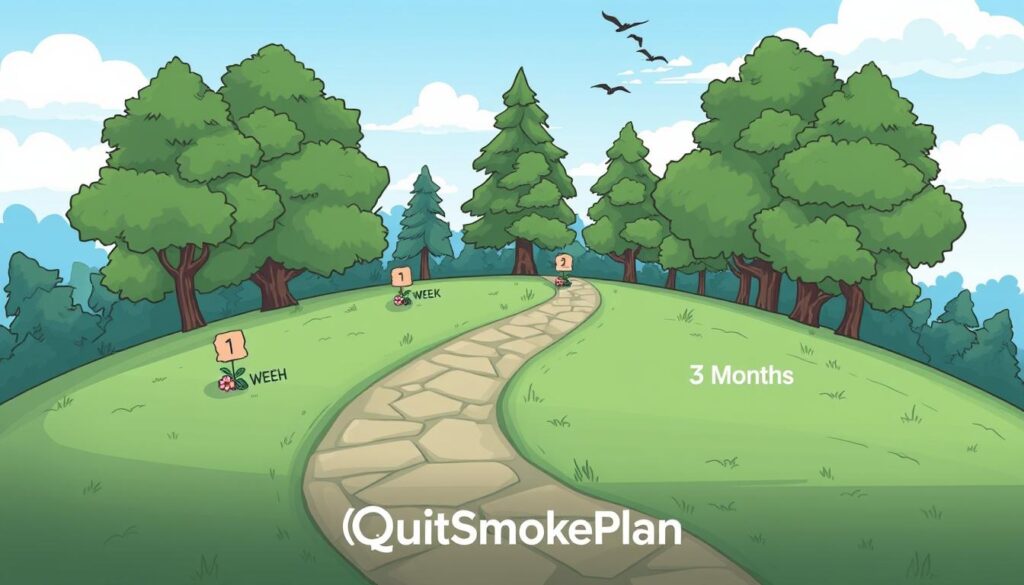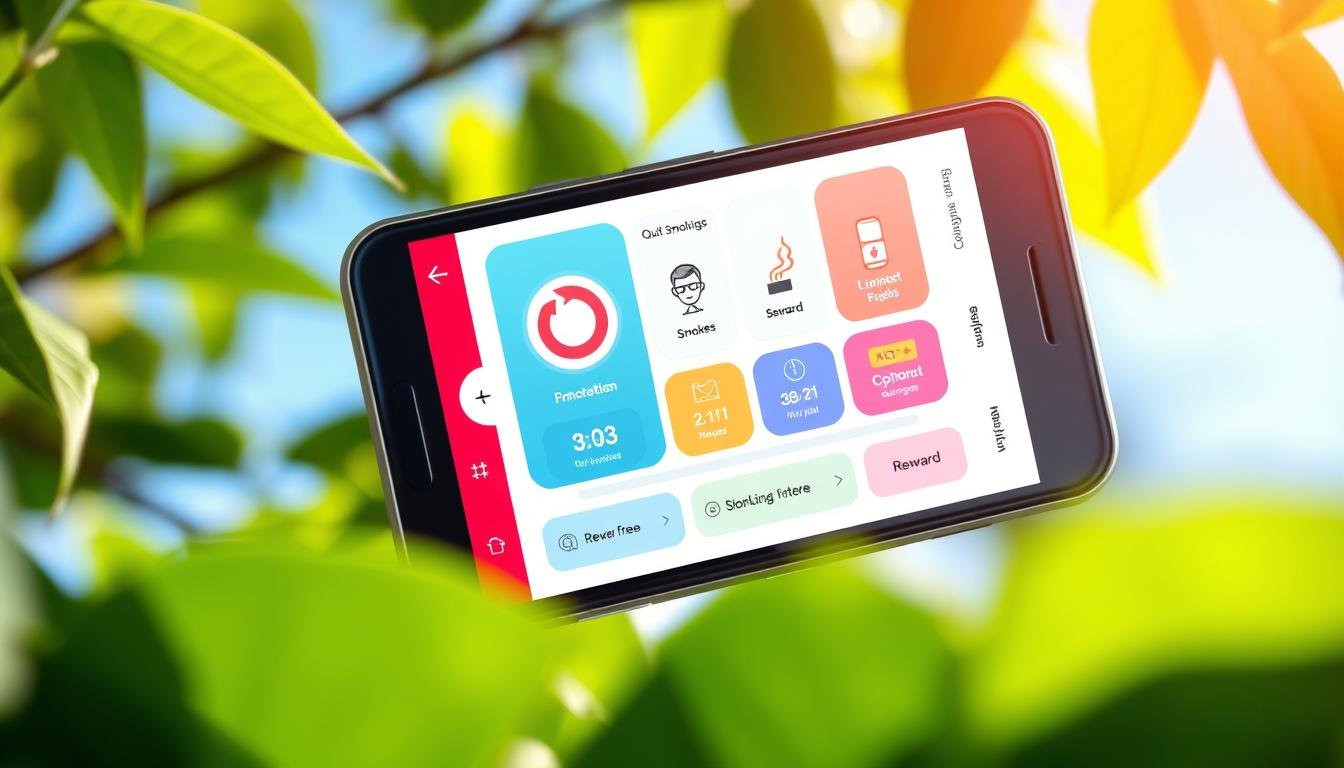“The future belongs to those who believe in the beauty of their dreams.” This quote by Eleanor Roosevelt shows the power of a Personalized Quit Smoking Plan. Quitting smoking seems hard, but a plan made just for you can help. It focuses on your habits and what makes you want to smoke.
This plan looks at the physical, emotional, and environmental reasons you smoke. It’s not just about stopping the habit. It’s about changing your life for the better.
Many people try to quit smoking several times before they succeed. A plan made just for you can help you quit for good. For example, quitting can save you over $1,800 a year. That’s more than $18,000 in ten years1.
This program does more than just help you quit. It helps you live a healthier life. By making a quit plan and getting support, you can start your journey to a smoke-free life2.
Key Takeaways
- A Personalized Quit Smoking Plan tailors quitting strategies to your unique habits.
- Many individuals try quitting several times before succeeding.
- Quitting smoking can lead to substantial financial savings.
- Support systems like quitlines can significantly aid your cessation efforts.
- Combining multiple quit aids may enhance your chances of success.
- Developing a personalized approach improves commitment and continuity of care.
The Importance of a Tailored Approach to Quitting Smoking
Using a tailored approach to quit smoking can really help you succeed. Everyone has their own reasons for smoking and personal situations. That’s why it’s key to have a plan that fits you.
General plans often don’t work well. They can make you feel stuck and might lead you to start smoking again. A plan made just for you takes into account your smoking habits and personal life.
Studies show that making plans based on your own needs can boost your chances of quitting. It also makes you happier with the quitting process . Making programs fit different groups can also help a lot. But, the best results come from making sure everyone has access to effective treatments3
It’s very important to have a plan that fits you. Having support that understands your struggles is crucial. It helps a lot to have both behavioral and medication support.
Research shows that personalized plans can lead to a 44% success rate. This is much better than many standard plans4.
Understanding Your Smoking Triggers
Knowing your smoking triggers is key to quitting. Triggers can be emotional, like stress or happiness, or tied to daily habits, like coffee. Social situations, like parties, can also trigger cravings. By understanding these triggers, you can better handle cravings and quit smoking with quit smoking help.

Emotional triggers include stress, happiness, and loneliness5. Habits like drinking or watching TV can also trigger cravings5. These cravings usually last 5 to 10 minutes and can be managed with gum or lozenges6.
Every smoker’s relationship with nicotine is different. Withdrawal symptoms can be triggered by smells or handling smoking items5. It’s vital to have personalized strategies to manage cravings. Physical activities can help, offering a healthy outlet6.
Social support is crucial in overcoming smoking triggers. Friends and family support can greatly increase your chances of quitting7. Quitlines offer immediate support, making your journey easier. Understanding your triggers helps you create a successful quit plan.
The Benefits of a Personalized Quit Smoking Plan
A personalized quit smoking plan offers many benefits. It’s made just for you, based on your smoking habits and lifestyle. This approach helps you quit smoking for good. Studies show it can really work, making it a smart choice8.
Customized Strategies for Individual Needs
Getting a plan that fits you is key to quitting. Nicotine replacement therapy (NRT) can help a lot. It comes in gum, patches, and more, helping with withdrawal symptoms like irritability and anxiety8.
Addressing Emotional and Environmental Triggers
It’s important to tackle emotional and environmental triggers. Knowing what makes you want to smoke helps you avoid it. Having friends and family support you can make a big difference89. With their help, you can face quitting challenges and stay motivated.
Setting Realistic Goals for Quitting
Setting realistic goals for quitting is key to becoming smoke-free. It keeps you motivated and gives you a clear plan. The S.M.A.R.T. goal framework helps a lot. It means Specific, Measurable, Achievable, Realistic, and Timely.
Using this framework can really help you quit for good. Studies show people who set goals do better than those who don’t10. Make a quit day plan with specific dates and goals to reach before quitting.
Creating a Quit Day Timeline
Pick a specific date to stop smoking. Plan to cut down on cigarettes before that. Having clear goals helps you stay focused and committed to quitting.
Check your progress often. This helps you see if you’re sticking to your plan. It also makes you feel good about your progress.
Measuring Progress Over Time
Measuring progress in smoking cessation is important. Celebrate small wins like smoke-free weeks or better health. Regular checks help you see how far you’ve come.
Remember, quitting smoking can save lives. It’s a big deal. Make your plan fun and rewarding to keep you going.

How a Personalized Quit Smoking Plan Enhances Motivation
Personalized quit smoking plans are key to boosting your motivation to quit. They involve the right support systems in your journey. Family support is crucial, offering encouragement and emotional security.
Involving Family and Friends in Your Journey
Getting family and friends involved makes your commitment stronger. Their support boosts your motivation and reminds you of your reasons for quitting. Personal connections are essential during tough moments, like withdrawal.
Utilizing Support Groups and Counseling
Support groups and counseling are vital for success. They offer shared experiences and coping strategies. This helps you deal with withdrawal symptoms like irritability and anxiety.
Engaging in a community shows you’re not alone. Many others face similar challenges. This exchange of techniques and support strengthens your resolve. Research proves that counseling with medication is highly effective11.
Personalized coaching provides tailored guidance. It’s important to set a quit date two weeks ahead. This allows for effective preparation11.
Combining family support, peer connections, and professional guidance creates a strong motivation environment. For more on creating a personalized quit smoking plan, check out this resource121311.
Exploring Different Quit Smoking Options
Starting your journey to quit smoking can be exciting. You can try many effective methods to help you. These include nicotine replacement therapy and prescription medications, tailored to your needs.
Nicotine Replacement Therapy
Nicotine Replacement Therapy (NRT) offers several options like patches, lozenges, and gums. These can help reduce withdrawal symptoms and cravings. Studies show that using a mix of NRT, like patches and gum, can boost your chances of quitting14.
This approach tackles physical dependence and helps change your smoking habits. It’s a powerful tool in your fight against smoking.
Prescription Medications
Prescription drugs like varenicline (Chantix) and bupropion hydrochloride can help manage cravings and withdrawal. Varenicline reduces the urge to smoke and lessens nicotine’s pleasure. Bupropion lowers cravings15.
But, it’s important to know about possible side effects. Common issues with varenicline include nausea, constipation, and trouble sleeping14. Always talk to your doctor to find the right fit for you.

Utilizing Technology for Smoking Cessation
Technology has changed how we quit smoking. There are many apps and online groups to help. They offer personalized help and connect you with others trying to quit.
Apps and Online Support Communities
Many apps help with cravings and tracking triggers. They help you stay on track and engaged. For example, the Smart-T2 app helped 22% of users stay smoke-free for 12 weeks16.
Online forums let you share your journey and get support. This boosts your motivation and determination.
Tracking Progress with Wearable Devices
Wearable tech is key in quitting smoking. It monitors your health in real-time. It tracks heart rate and stress, helping you manage quitting’s physical side.
Seeing your progress can motivate you. Getting updates and reminders helps you stay on track. This increases your chances of quitting for good17.
Building a Strong Support Network
Creating a strong support network is key to quitting smoking. Quitlines offer immediate help from professionals, giving you advice and counseling. Many people find comfort and motivation in these support systems, making them crucial in tough times.
The Role of Quitlines
Quitlines are vital for those trying to quit smoking. Studies show many smokers use these services, boosting their chances of quitting18. The New York State Quitline and others offer free help, creating a supportive environment for those quitting18. Using these services gives you professional guidance and helps you feel less alone during the quitting journey.
Finding a Quit Buddy
Having a quit buddy can greatly help you succeed. Research shows that having someone to support you makes you three times more likely to quit19. This partnership brings motivation and accountability, helping you share your journey’s ups and downs. The emotional and practical support you get can make quitting easier, especially when cravings hit hard18
In summary, building a strong support network is essential for quitting smoking. Using quitlines and having a quit buddy can make quitting easier, making your journey to a smoke-free life more attainable20.
Implementing Coping Strategies for Cravings
Dealing with cravings is key to quitting smoking for good. Using effective strategies can help you fight strong urges and make choices that help you stay on track. Deep breathing and fun activities can help you manage cravings better and lower the chance of going back to smoking.
Deep Breathing and Relaxation Techniques
Deep breathing techniques for smoking cessation are a strong tool against stress and anxiety from cravings. It helps calm your mind and body, taking your focus off smoking. This method can change how you think about stress, helping you handle it in healthier ways2122.
Staying Busy and Distracted
Keeping busy is a big help in fighting cravings. Activities like exercise, hobbies, or spending time with friends can distract you. It’s important to have plans for when cravings hit, like chewing sugarless gum or starting a creative project2322. A busy schedule and good coping strategies can help you get through tough times and reduce the risk of relapse.
| Coping Strategy | Description | Benefits |
|---|---|---|
| Deep Breathing | Involves inhaling deeply and exhaling slowly to promote relaxation. | Reduces stress levels, distracts from cravings. |
| Engaging in Activities | Includes hobbies, exercise, or spending time with friends. | Provides positive distractions and fosters social support. |
| Nontobacco Substitutes | Using items like gum or sugarless candy to satisfy oral fixation. | Helps curb cravings by addressing physical urges. |
Adding these strategies to your quit plan can help you control cravings and live a healthier, smoke-free life212322.
Overcoming Setbacks in Your Quit Journey
Starting to quit smoking can be tough. It’s important to see challenges as chances to grow. Recognizing when you slip up helps you learn and stay on track.
Recognizing Relapses as Learning Opportunities
About 60% of people face setbacks, like smoking again after quitting24. Each time you slip up, you learn what triggers your cravings. Having a support system can really help; those with friends and family are three times more likely to stay smoke-free24.
It’s key to think about these moments as part of your journey. They teach you valuable lessons.
Adjusting Your Personalized Quit Plan
After a slip-up, it’s time to tweak your quit plan. Studies show that making changes can boost your chances of quitting for good by 40%24. Adding rewards to your plan can motivate you, with an 80% success rate in reaching goals24.
Using different methods, like deep breathing or exercise, can also help. These can improve your chances of beating cravings by up to 75%25.

The Importance of Staying Positive
Having a positive mindset is key when you’re quitting smoking. It helps you stay strong and see your progress. Even when quitting seems tough, keep your eyes on the future.
Celebrating Small Victories
Every day without smoking is a big win. Celebrating these small victories boosts your motivation. It shows you’re on the right path.
Studies show that making a personal quit plan can double your chances of staying smoke-free20.
Affirmation Techniques
Using affirmations can boost your confidence. Daily positive affirmations help you stay committed to quitting. Phrases like “I can beat cravings” or “Every smoke-free day is a step to better health” shape your mindset.
Adding this to your daily routine gives you ongoing support. It helps you stay positive and focused on quitting.
Remember, you can always get help if you need it. Resources like personalized quit plans or mobile apps can help you on your journey26.
Evaluating Your Progress with a Personalized Quit Smoking Plan
Checking your progress is key to your quit smoking plan. It helps you stay on track and feel responsible. Using different ways to check your progress helps you see how well you’re doing.
Using Biochemical Methods for Validation
Using biochemical tests shows you’re making progress. Tests like saliva or breath tests measure nicotine levels. They show how much you’ve cut down on smoking.
These tests not only prove your hard work but also keep you motivated. They help you keep going on your journey to quit smoking.
Self-Assessment Tools
Self-assessment is also crucial. Tools like journals and apps help you track your journey. They let you reflect on your successes and challenges.
These tools help you see where you’re doing well and where you need to improve. They let you adjust your plan as needed.
| Method | Description | Benefit |
|---|---|---|
| Biochemical Methods | Includes saliva and breath tests to measure nicotine levels | Provides objective validation of smoking reduction |
| Self-Assessment Tools | Journals and apps for tracking progress and emotions | Encourages reflection and accountability in your quit journey |

By using biochemical tests and self-assessment tools, you get a full picture of your progress. This combination helps you understand your journey better. It also makes you more committed to living a smoke-free life2728.
Integrating Healthy Lifestyle Changes
Changing your lifestyle after quitting smoking is key to keeping your commitment. Healthy habits after quitting smoking help a lot in your recovery. Regular exercise boosts both physical and mental health. A balanced diet helps your body heal and keeps you strong against cravings.
Adopting Regular Exercise Routines
Adding regular exercise to your routine can help you stay smoke-free for good. Exercise reduces stress, helps with withdrawal symptoms, and makes you feel better by releasing endorphins. Studies show that exercise makes you healthier and helps you stay smoke-free, with a 2.19 relative risk29. It’s a great tool to fight the physical and mental challenges of quitting.
Choosing a Balanced Diet for Better Health
Eating well is crucial for your health while quitting smoking. Eating foods rich in nutrients can help with withdrawal and cravings. Research shows that diet and exercise together can lower health risks like diabetes, with a 0.67 relative risk29. Eating healthy meals helps you stay on track as you avoid smoking.
| Healthy Lifestyle Change | Benefits |
|---|---|
| Regular Exercise | Enhances mood, reduces cravings, increases odds of quitting |
| Balanced Diet | Improves health, supports recovery, reduces withdrawal symptoms |
These healthy lifestyle changes after quitting smoking boost your chances of success. They also improve your life as you move towards a smoke-free future.
Remember, taking care of your body is just as important as breaking free from addiction.
Expert Opinions on Personalized Quit Smoking Plans
Getting advice from experts on quitting smoking can really help. They say that plans made just for you are key. These plans mix therapy with medicine, making quitting more likely. Since smoking causes about 6 million deaths yearly, their advice is very important30.
Insights from Healthcare Professionals
Experts say getting help to quit is much better than trying alone. For example, in the UK, NHS Stop Smoking Services help 35% of people quit in just four weeks. This is much higher than the less than 5% who try but don’t stick with it30. They also say that plans made just for you can really help more people join and stay in quitting programs.
Case Studies of Successful Quitters
Looking at stories of people who quit can give us ideas. For instance, those who made a plan to quit did much better. In fact, 59% of those who made many plans were able to quit, compared to 29% with few plans31. This shows that having a clear plan and taking steps to quit really works. So, encouraging smokers to make a plan can really help them quit.

| Focus Area | Statistic |
|---|---|
| Quit Rate in NHS Services | 35% within 4 weeks30 |
| Utilization of Services | Less than 5% of smokers30 |
| Quit Success with Plans | 29% with few plans vs. 59% with many31 |
| Engagement in Trial Sessions | Higher participation leads to better outcomes30 |
Future Trends in Smoking Cessation Programs
The world of quitting smoking is changing fast. New research and tech are leading the way. Personalized programs are becoming more popular because they meet each person’s needs.
These programs focus on keeping users engaged. They also use real-time feedback to help.
Emerging Research on Personalized Approaches
Research shows that tailored programs help more people quit. For example, the EX Program can boost quitting chances by up to 40%32. It has helped millions quit over 15 years32.
As more people learn about these programs, they want to use them. This is changing how we fight smoking.
The Role of Mobile Health Technology
Mobile phones are almost everywhere, with 80% of people owning one33. This makes mobile health tech for quitting smoking very important33. With over 6.8 billion mobile subscriptions, there’s a huge chance to help smokers33.
Apps can track progress and give instant feedback. This helps smokers stay on track with their plans. In developing countries, mobile health services have grown a lot, showing a big shift towards mobile health33.
As we move forward, mobile tech will be key. It will offer support and resources that fit each person’s needs.
Conclusion
A personalized quit smoking plan is key to your success. It’s made just for you, based on your life and needs. Knowing your triggers and setting achievable goals helps a lot. Plus, using the right resources can make a big difference.
Studies show that it takes about five tries to quit smoking for good34. This shows how important having support is. It keeps you going even when it’s tough.
Checking in with your progress and getting help from experts and friends keeps you on track. Tools and resources can really help you stay on the right path35. Remember, quitting smoking is all about change and staying positive. It’s a big step towards a healthier life.
Using strategies that fit you and adjusting your plan as needed is key. It helps you face challenges and celebrate small wins. Remember, support and self-management are key to a smoke-free life36.
FAQ
What is a Personalized Quit Smoking Plan?
Why is a tailored approach important for quitting smoking?
How do I identify my smoking triggers?
What are the benefits of a Personalized Quit Smoking Plan?
How do I set realistic goals for quitting?
How does a Personalized Quit Smoking Plan enhance motivation?
What different options are available in a quit smoking program?
How can technology support my quit smoking journey?
What role does a support network play in quitting smoking?
What coping strategies can I implement to manage cravings?
How can I overcome setbacks during my quit journey?
Why is maintaining a positive mindset important?
How do I evaluate my progress in quitting smoking?
How do healthy lifestyle changes support my quit smoking efforts?
What insights can healthcare professionals provide on personalized quit smoking plans?
What future trends are expected in smoking cessation programs?
Source Links
- https://www.ahrq.gov/sites/default/files/wysiwyg/professionals/clinicians-providers/guidelines-recommendations/tobacco/clinicians/tearsheets/tearsheet.pdf
- https://www.cancer.org/cancer/risk-prevention/tobacco/guide-quitting-smoking/deciding-to-quit-smoking-and-making-a-plan.html
- https://www.theexprogram.com/resources/blog/when-do-tailored-interventions-to-quit-smoking-work-best/
- https://www.lung.org/help-support/corporate-wellness/help-employees-stop-smoking
- https://smokefree.gov/challenges-when-quitting/cravings-triggers/know-your-triggers
- https://www.mayoclinic.org/healthy-lifestyle/quit-smoking/in-depth/nicotine-craving/art-20045454
- https://smokingcessationleadership.ucsf.edu/ready-quit
- https://smokefree.gov/quit-smoking/getting-started/prepare-to-quit
- https://www.nhs.uk/better-health/quit-smoking/
- https://www.copdfoundation.org/COPD360social/Community/Questions-and-Answers/Check-In-How-Do-You-Set-Goals-for-Quitting-Smoking.aspx
- https://www.gohealthuc.com/library/smoking-cessation-assistance
- https://pivot.co/blog/customized-smoking-cessation-program
- https://www.helpguide.org/mental-health/addiction/how-to-quit-smoking
- https://www.everydayhealth.com/stop-smoking-pictures/the-best-and-worst-ways-to-quit-smoking.aspx
- https://www.ncbi.nlm.nih.gov/books/NBK555596/
- https://pmc.ncbi.nlm.nih.gov/articles/PMC7091024/
- https://pmc.ncbi.nlm.nih.gov/articles/PMC6082685/
- https://www.urmc.rochester.edu/news/publications/dialogue/how-do-i-quit-smoking-creating-a-plan-to-kick-the
- https://www.quitclinics.com/blog/building-a-strong-support-system-for-quitting-smoking/
- https://smokefree.gov/quit-smoking/getting-started/steps-to-manage-quit-day
- https://rxforchange.ucsf.edu/download.php?file=A6 COPING.pdf
- https://www.cancer.org/cancer/risk-prevention/tobacco/guide-quitting-smoking/quitting-smoking-help-for-cravings-and-tough-situations.html
- https://geodehealth.com/addiction/smoking-cessation/
- https://carenetconsultants.co.za/creating-a-quit-smoking-plan-step-by-step-guide-on-making-a-personalized-quit-smoking-plan/
- https://www.mondaycampaigns.org/quit-stay-quit/keep-your-quit-with-proper-planning
- https://www.cancer.org/cancer/risk-prevention/tobacco/guide-quitting-smoking/benefits-of-quitting-smoking-over-time.html
- https://www.tobaccoinduceddiseases.org/Evaluating-smokers-opinions-on-smoking-and-customized-cessation-in-a-Thailand-University,185293,0,2.html
- https://pmc.ncbi.nlm.nih.gov/articles/PMC4688053/
- https://pmc.ncbi.nlm.nih.gov/articles/PMC5755775/
- https://pmc.ncbi.nlm.nih.gov/articles/PMC5497090/
- https://bmcpublichealth.biomedcentral.com/articles/10.1186/1471-2458-13-393
- https://truthinitiative.org/exprogram
- https://pmc.ncbi.nlm.nih.gov/articles/PMC4263966/
- https://www.aafp.org/pubs/afp/issues/2012/0315/p591.html
- https://cancer.ca/en/living-with-cancer/how-we-can-help/get-help-to-quit-smoking
- https://pmc.ncbi.nlm.nih.gov/articles/PMC9717394/




